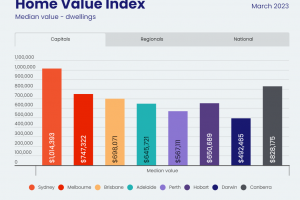National home values up 0.6% in March

National home values up 0.6% in March
After remaining virtually flat in February (-0.1%), CoreLogic’s national Home Value Index (HVI) posted the first month-on-month rise since April 2022, up 0.6% in March.
Dwelling values were higher across the four largest capital cities and most of the broad ‘rest-of-state’ regions, led by a 1.4% gain in Sydney.
CoreLogic’s Research Director, Tim Lawless, put the rise down to a combination of low advertised stock levels, extremely tight rental conditions and additional demand from overseas migration.
“Although interest rates are high and there is an expectation the economy will slow through the year, it’s clear other factors are now placing upwards pressure on home prices,” Mr Lawless said.
“Advertised supply has been below average since September last year, with capital city listing numbers ending March almost -20% below the previous five-year average. Purchasing activity has also fallen but not as much as available supply; capital city sales activity was estimated to be roughly -7% below the previous five-year average through the March quarter.
“With rental markets this tight, it’s likely we are seeing some spillover from renting into purchasing, although, with mortgage rates so high, not everyone who wants to buy will be able to qualify for a loan. Similarly, with net overseas migration at record levels and rising, there is a chance more permanent or long-term migrants who can afford to, will skip the rental phase and fast track a home purchase simply because they can’t find rental accommodation.”
The lift in housing values has been most evident across the upper quartile of Sydney’s housing market. House values within the most expensive quarter of Sydney’s market were up 2.0% in March and the upper quartile of the Sydney unit market was 1.4% higher over the month.
“Sydney upper quartile house values fell by -17.4% from their peak in January 2022 to a recent low in January 2023, the largest drop from the market peak of any capital city market segment. We may be seeing some opportunistic buyers coming back into the market where prices have fallen the most,” Mr Lawless said.
Regional housing markets have mostly shown firmer housing conditions as well, with the combined regionals index rising 0.2% over the month. Housing values across Regional WA and Regional SA remain at cyclical highs despite 10 rate hikes. SA’s Fleurieu-Kangaroo Island SA3 sub-region led capital gains over the month with a 2.6% rise in dwelling values followed by Dubbo, NSW (2.5%), Wellington, Victoria (2.4%) and Mid West, WA (2.1%).
“The best performing regional markets are quite different to what we were seeing through the recent growth cycle,” Mr Lawless said.
“In today’s market it is mainly rural areas that are seeing the strongest increases, rather than the commutable coastal and lifestyle markets that were booming through the upswing. However, we are seeing some subtle growth return to regions within commuting distance of the major capitals, after many recorded a sharp drop in values.”
But housing values aren’t rising everywhere. Hobart recorded the largest drop in home values among the capital cities, down -0.9% over the month. Housing values across the southern most capital have fallen -12.9% since peaking in May last year; overtaking Sydney as the largest cumulative fall from peak across the capital cities. However, the pace of decline has been easing across Hobart over the past three months.
Canberra (-0.5%), Darwin (-0.4%) and Adelaide (-0.1%) also recorded a decline in values over the month, as did Regional Victoria (-0.1%) and Regional Tasmania (-0.7%).
Source: CoreLogic Research
